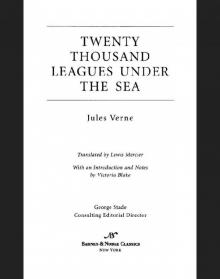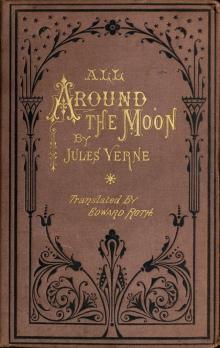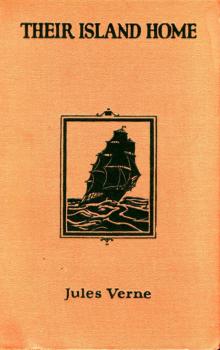- Home
- Jules Verne
Robur-le-conquerant. English Page 3
Robur-le-conquerant. English Read online
Page 3
Chapter III
A VISITOR IS ANNOUNCED
The many experiments made during this last quarter of the nineteenthcentury have given considerable impetus to the question of guidableballoons. The cars furnished with propellers attached in 1852 to theaerostats of the elongated form introduced by Henry Giffard, themachines of Dupuy de Lome in 1872, of the Tissandier brothers in1883, and of Captain Krebs and Renard in 1884, yielded many importantresults. But if these machines, moving in a medium heavier thanthemselves, maneuvering under the propulsion of a screw, working atan angle to the direction of the wind, and even against the wind, toreturn to their point of departure, had been really "guidable," theyhad only succeeded under very favorable conditions. In large, coveredhalls their success was perfect. In a calm atmosphere they did verywell. In a light wind of five or six yards a second they still moved.But nothing practical had been obtained. Against a miller's wind--nineyards a second--the machines had remained almost stationary.Against a fresh breeze--eleven yards a second--they would haveadvanced backwards. In a storm--twenty-seven to thirty-three yards asecond--they would have been blown about like a feather. In ahurricane--sixty yards a second--they would have run the risk ofbeing dashed to pieces. And in one of those cyclones which exceed ahundred yards a second not a fragment of them would have been left.It remained, then, even after the striking experiments of CaptainsKrebs and Renard, that though guidable aerostats had gained a littlespeed, they could not be kept going in a moderate breeze. Hence theimpossibility of making practical use of this mode of aeriallocomotion.
With regards to the means employed to give the aerostat its motion agreat deal of progress had been made. For the steam engines of HenryGiffard, and the muscular force of Dupuy de Lome, electric motors hadgradually been substituted. The batteries of bichromate of potassiumof the Tissandier brothers had given a speed of four yards a second.The dynamo-electric machines of Captain Krebs and Renard haddeveloped a force of twelve horsepower and yielded a speed of six anda half yards per second.
With regard to this motor, engineers and electricians had beenapproaching more and more to that desideratum which is known as asteam horse in a watch case. Gradually the results of the pile ofwhich Captains Krebs and Renard had kept the secret had beensurpassed, and aeronauts had become able to avail themselves ofmotors whose lightness increased at the same time as their power.
In this there was much to encourage those who believed in theutilization of guidable balloons. But yet how many good people thereare who refuse to admit the possibility of such a thing! If theaerostat finds support in the air it belongs to the medium in whichit moves; under such conditions, how can its mass, which offers somuch resistance to the currents of the atmosphere, make its wayagainst the wind?
In this struggle of the inventors after a light and powerful motor,the Americans had most nearly attained what they sought. Adynamo-electric apparatus, in which a new pile was employed thecomposition of which was still a mystery, had been bought from itsinventor, a Boston chemist up to then unknown. Calculations made withthe greatest care, diagrams drawn with the utmost exactitude, showedthat by means of this apparatus driving a screw of given dimensions adisplacement could be obtained of from twenty to twenty-two yards asecond.
Now this was magnificent!
"And it is not dear," said Uncle Prudent, as he handed to theinventor in return for his formal receipt the last installment of thehundred thousand paper dollars he had paid for his invention.
Immediately the Weldon Institute set to work. When there comes alonga project of practical utility the money leaps nimbly enough fromAmerican pockets. The funds flowed in even without its beingnecessary to form a syndicate. Three hundred thousand dollars cameinto the club's account at the first appeal. The work began under thesuperintendence of the most celebrated aeronaut of the United States,Harry W. Tinder, immortalized by three of his ascents out of athousand, one in which he rose to a height of twelve thousand yards,higher than Gay Lussac, Coxwell, Sivet, Croce-Spinelli, Tissandier,Glaisher; another in which he had crossed America from New York toSan Francisco, exceeding by many hundred leagues the journeys ofNadar, Godard, and others, to say nothing of that of John Wise, whoaccomplished eleven hundred and fifty miles from St. Louis toJefferson county; the third, which ended in a frightful fall fromfifteen hundred feet at the cost of a slight sprain in the rightthumb, while the less fortunate Pilatre de Rozier fell only sevenhundred feet, and yet killed himself on the spot!
At the time this story begins the Weldon Institute had got their workwell in hand. In the Turner yard at Philadelphia there reposed anenormous aerostat, whose strength had been tried by highly compressedair. It well merited the name of the monster balloon.
How large was Nadar's Geant? Six thousand cubic meters. How large wasJohn Wise's balloon? Twenty thousand cubic meters. How large was theGiffard balloon at the 1878 Exhibition? Twenty-five thousand cubicmeters. Compare these three aerostats with the aerial machine of theWeldon Institute, whose volume amounted to forty thousand cubicmeters, and you will understand why Uncle Prudent and his colleagueswere so justifiably proud of it.
This balloon not being destined for the exploration of the higherstrata of the atmosphere, was not called the Excelsior, a name whichis rather too much held in honor among the citizens of America. No!It was called, simply, the "Go-Ahead," and all it had to do was tojustify its name by going ahead obediently to the wishes of itscommander.
The dynamo-electric machine, according to the patent purchased by theWeldon Institute, was nearly ready. In less than six weeks the"Go-Ahead" would start for its first cruise through space.
But, as we have seen, all the mechanical difficulties had not beenovercome. Many evenings had been devoted to discussing, not the formof its screw nor its dimensions, but whether it ought to be putbehind, as the Tissandier brothers had done, or before as CaptainsKrebs and Renard had done. It is unnecessary to add that thepartisans of the two systems had almost come to blows. The group of"Beforists" were equaled in number by the group of "Behindists."Uncle Prudent, who ought to have given the casting vote--UnclePrudent, brought up doubtless in the school of Professor Buridan--couldnot bring himself to decide.
Hence the impossibility of getting the screw into place. The disputemight last for some time, unless the government interfered. But inthe United States the government meddles with private affairs aslittle as it possibly can. And it is right.
Things were in this state at this meeting on the 13th of June, whichthreatened to end in a riot--insults exchanged, fisticuffssucceeding the insults, cane thrashings succeeding the fisticuffs,revolver shots succeeding the cane thrashings--when at thirty-sevenminutes past eight there occurred a diversion.
The porter of the Weldon Institute coolly and calmly, like apoliceman amid the storm of the meeting, approached the presidentialdesk. On it he placed a card. He awaited the orders that UnclePrudent found it convenient to give.
Uncle Prudent turned on the steam whistle, which did duty for thepresidential bell, for even the Kremlin clock would have struck invain! But the tumult slackened not.
Then the president removed his hat. Thanks to this extreme measure asemi-silence was obtained.
"A communication!" said Uncle Prudent, after taking a huge pinch fromthe snuff-box which never left him.
"Speak up!" answered eighty-nine voices, accidentally in agreement onthis one point.
"A stranger, my dear colleagues, asks to be admitted to the meeting."
"Never!" replied every voice.
"He desires to prove to us, it would appear," continued UnclePrudent, "that to believe in guiding balloons is to believe in theabsurdest of Utopias!"
"Let him in! Let him in!"
"What is the name of this singular personage?" asked secretary PhilEvans.
"Robur," replied Uncle Prudent.
"Robur! Robur! Robur!" yelled the assembly. And the welcome accordedso quickly to the curious name was chiefly due to the WeldonInstitute hoping to vent its exasperation on
the head of him who boreit!

 Michael Strogoff; Or the Courier of the Czar: A Literary Classic
Michael Strogoff; Or the Courier of the Czar: A Literary Classic Voyage au centre de la terre. English
Voyage au centre de la terre. English Journey Through the Impossible
Journey Through the Impossible The Castaways of the Flag
The Castaways of the Flag L'île mystérieuse. English
L'île mystérieuse. English Maître du monde. English
Maître du monde. English Around the World in Eighty Days
Around the World in Eighty Days A Voyage in a Balloon
A Voyage in a Balloon From the Earth to the Moon, Direct in Ninety-Seven Hours and Twenty Minutes: and a Trip Round It
From the Earth to the Moon, Direct in Ninety-Seven Hours and Twenty Minutes: and a Trip Round It Paris in the Twentieth Century
Paris in the Twentieth Century City in the Sahara - Barsac Mission 02
City in the Sahara - Barsac Mission 02 The English at the North Pole
The English at the North Pole The Field of Ice
The Field of Ice From the Earth to the Moon
From the Earth to the Moon Un capitaine de quinze ans. English
Un capitaine de quinze ans. English The Mysterious Island
The Mysterious Island Les indes-noirs. English
Les indes-noirs. English Robur-le-conquerant. English
Robur-le-conquerant. English Propeller Island
Propeller Island Around the World in Eighty Days. Junior Deluxe Edition
Around the World in Eighty Days. Junior Deluxe Edition Les forceurs de blocus. English
Les forceurs de blocus. English In the Year 2889
In the Year 2889 Journey to the Centre of the Earth
Journey to the Centre of the Earth Twenty Thousand Leagues Under the Sea
Twenty Thousand Leagues Under the Sea From the Earth to the Moon; and, Round the Moon
From the Earth to the Moon; and, Round the Moon Vingt mille lieues sous les mers. English
Vingt mille lieues sous les mers. English Cinq semaines en ballon. English
Cinq semaines en ballon. English Twenty Thousand Leagues under the Seas
Twenty Thousand Leagues under the Seas Face au drapeau. English
Face au drapeau. English Michael Strogoff; Or, The Courier of the Czar
Michael Strogoff; Or, The Courier of the Czar Un billet de loterie. English
Un billet de loterie. English The Secret of the Island
The Secret of the Island Off on a Comet! a Journey through Planetary Space
Off on a Comet! a Journey through Planetary Space Into the Niger Bend: Barsac Mission, Part 1
Into the Niger Bend: Barsac Mission, Part 1 All Around the Moon
All Around the Moon A Journey to the Center of the Earth - Jules Verne: Annotated
A Journey to the Center of the Earth - Jules Verne: Annotated 20000 Lieues sous les mers Part 2
20000 Lieues sous les mers Part 2 Robur-le-Conquerant
Robur-le-Conquerant Les Index Noires
Les Index Noires Michael Strogoff; or the Courier of the Czar
Michael Strogoff; or the Courier of the Czar 20000 Lieues sous les mers Part 1
20000 Lieues sous les mers Part 1 Twenty Thousand Leagues Under the Sea (Barnes & Noble Classics Series)
Twenty Thousand Leagues Under the Sea (Barnes & Noble Classics Series) Five Weeks In A Balloon
Five Weeks In A Balloon Journey to the Center of the Earth
Journey to the Center of the Earth 20,000 Leagues Under the Sea
20,000 Leagues Under the Sea Journey to the Center of the Earth (Barnes & Noble Classics Series)
Journey to the Center of the Earth (Barnes & Noble Classics Series) Adrift in the Pacific-Two Years Holiday
Adrift in the Pacific-Two Years Holiday The Collected Works of Jules Verne: 36 Novels and Short Stories (Unexpurgated Edition) (Halcyon Classics)
The Collected Works of Jules Verne: 36 Novels and Short Stories (Unexpurgated Edition) (Halcyon Classics) The Survivors of the Chancellor
The Survivors of the Chancellor Their Island Home
Their Island Home Le Chateau des Carpathes
Le Chateau des Carpathes Les Cinq Cents Millions de la Begum
Les Cinq Cents Millions de la Begum The Floating Island
The Floating Island Cinq Semaines En Ballon
Cinq Semaines En Ballon Autour de la Lune
Autour de la Lune